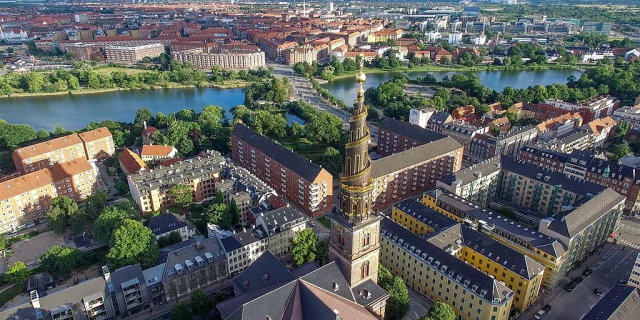Tivoli (København)
( Tivoli Gardens )
Tivoli Gardens, also known simply as Tivoli, is an amusement park and pleasure garden in Copenhagen, Denmark. The park opened on 15 August 1843 and is the third-oldest operating amusement park in the world, after Dyrehavsbakken in nearby Klampenborg, also in Denmark, and Wurstelprater in Vienna, Austria.
With 4.6 million visitors in 2017, Tivoli is the most visited amusement park in Scandinavia and second-most popular seasonal amusement park in the world after Europa-Park. Tivoli is also the fifth-most visited amusement park in Europe, behind Disneyland Park, Europa-Park, Walt Disney Studios Park and Efteling. It is located in downtown Copenhagen, next to the Central rail station.
The amusement park was first called "Tivoli & Vauxhall";[1] "Tivoli" alluding to the Jardin de Tivoli in Paris (which in its turn had been named after Tivoli near Rome, Italy), and "Vauxhall" alluding to Vauxhall Gardens in London. It is mentioned in various books, such as Number the Stars by Lois Lowry, and was also used prominently in the 1961 science fiction film Reptilicus.
Tivoli's founder, Georg Carstensen (b. 1812 – d. 1857), obtained a five-year charter to create Tivoli by telling King Christian VIII that "when the people are amusing themselves, they do not think about politics". The monarch granted Carstensen use of roughly 15 acres (61,000 m2) of the fortified glacis outside Vesterport (the West Gate) for an annual rent. Until the 1850s Tivoli was outside the city, accessible from the city only through the Vesterport.
From its beginning Tivoli included a variety of attractions: buildings in the exotic style of an imaginary Orient: a theatre, band stands, restaurants and cafés, flower gardens, and mechanical amusement rides such as a merry-go-round and a primitive scenic railway. After dark, colored lamps illuminated the gardens. On certain evenings, specially designed fireworks could be seen reflected in Tivoli's lake, a remnant of the moat surrounding the city fortifications.
Composer Hans Christian Lumbye (b. 1810 – d. 1874) was Tivoli's musical director from 1843 to 1872. Lumbye was inspired by Viennese waltz composers such as the Strauss family (Johann Strauss I and his sons), and became known as the "Strauss of the North". Many of his compositions are specifically inspired by the gardens, including "Salute to the Ticket Holders of Tivoli", "Carnival Joys" and "A Festive Night at Tivoli". The Tivoli Symphony Orchestra still performs many of his works.
 Aerial photo of the park
Aerial photo of the parkIn 1874, a Chinese-style Pantomimeteatret (pantomime theatre) took the place of an older smaller theatre. The audience stands in the open, the stage being inside the building. The theatre's "curtain" is a mechanical peacock's tail. From the very beginning, the theatre was the home of Italian pantomimes, introduced in Denmark by the Italian Giuseppe Casorti. This tradition, dependent on the Italian Commedia dell'Arte, has been kept alive; it portrays the characters Cassander (the old father), Columbine (his beautiful daughter), Harlequin (her lover), and, especially popular with the youngest spectators, the stupid servant Pierrot. The absence of spoken dialogue is an advantage, for Tivoli is now an international tourist attraction.
In the late 19th and early 20th century, Tivoli also hosted human exhibitions.[2]
In 1943, Nazi sympathisers burnt many of Tivoli's buildings, including the concert hall, to the ground. Temporary buildings were constructed in their place and the park was back in operation after a few weeks.[3][page needed]
Tivoli is always evolving without abandoning its original charm or traditions. Georg Carstensen said in 1844: "Tivoli will never, so to speak, be finished", a sentiment echoed just over a century later when Walt Disney said of his own Tivoli-inspired theme park, "Disneyland will never be completed. It will continue to grow as long as there is imagination left in the world".[4]
In Danish, Icelandic, Norwegian and Swedish, the word tivoli has become synonymous with any amusement park.


































Add new comment